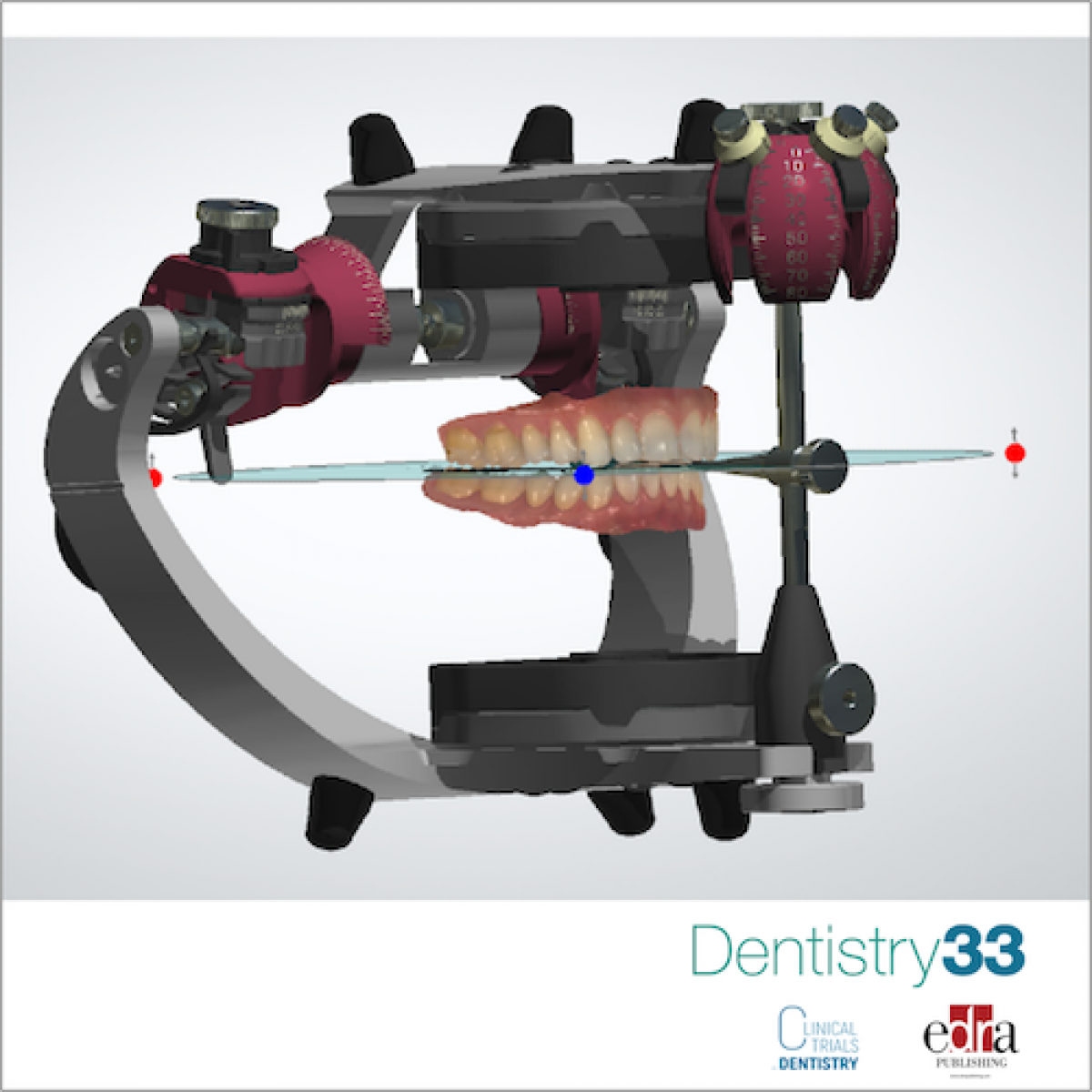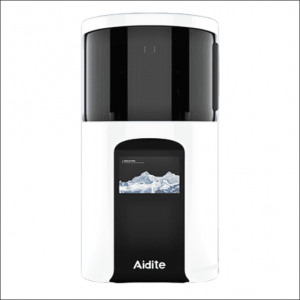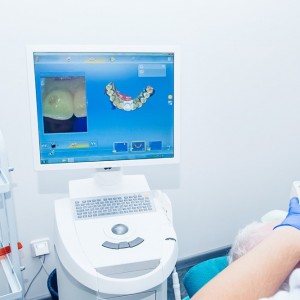
Maxilla orientation and occlusal plane recording in a digital workflow using a silicon key.
Edoardo Mancuso
Nowadays the digital dentistry has paved the way for a more efficient dental workflow. The many tools that have been integrated into digital technology have made dental procedures more accurate and simpler, replacing analog ones in an unprecedented manner, with advantages that include time efficiency, reliability, repeatability, and often, increased treatment quality. However, the digital maxillary cast mounting and occlusal plane orientation remain, so far, controversial.
Occlusal plane orientation is indeed one of the factors that helps establish an occlusion compatible with the function and parafunction of the stomatognathic system. The recording and transfer of the maxillary occlusal plane parallel to the horizon in the frontal view and parallel to the Camper plane in the sagittal view is key to the esthetic and functional outcome of complete mouth rehabilitations.
Following recent advances in digital dentistry, the cast mounting procedure has been digitalized through a wide range of techniques to address the shortcomings of the traditional facebow and to integrate the orientation of the maxillary cast into the digital workflow.
On this topic, Dr. Caponi and his team have recently written an interesting article published in the Journal of Prosthetic Dentistry with the aim to present a straightforward and reliable way of recording the maxillary cast position and orienting the occlusal reference plane by transferring standard tessellation language (STL) files to a computer-aided design (CAD) software program in a completely digital approach.
Technique:
The proposed technique is here briefly reported:
1) Three digital scans of the maxillary and mandibular dentition and the maxillomandibular relationship record are made to obtain STL data.
2) A polyvinyl siloxane index is placed over a Fox plane and positioned parallel to the horizon in frontal view and parallel to the Camper line in a profile view with the help of a bubble-level device placed over the Fox plane.
3) Once the PVS index is polymerized a vertical line corresponding to the facial midline and a horizontal line parallel to the fox plane is transferred on the surface of the PVS index using a scalpel. Then a maxillary scan is taken with the PVS index in place.
4) The intraoral STL files are imported into CAD software and the STL file of the maxillary impression are automatically overlapped to the STL file with the PVS index.
5) A virtual plane is then created and oriented parallel to the lower surface of the PVS index reference plane. A second plane parallel to the previous one is created and raised until it touches the incisal edge of the planned maxillary central incisor. This plane will represent the occlusal reference for functional and esthetic rehabilitation.
6) Using the articulator module in the cad software program the proposed occlusal plane is matched with the Bonwill triangle to finally design the virtual diagnostic waxing.
Discussion
A wide range of techniques have been adopted to digitally position the maxillary in a 3-dimensional space and to record the occlusal plane. However, one of the most frequent techniques entails using a CAD software platform to superimpose the extraoral frontal view image JPEG file (at maximum smile and with cheek retractors) over the intraoral upper maxilla scan STL file.
The authors of the article say that with this technique it is necessary to photograph the patient in a completely natural head position, and this could be often challenging. Moreover, in the article is added that to align 2 objects, the posterior and anterior points should be superimposed. Because of the nature of frontally captured photographs, posterior teeth, and distal surfaces are not represented adequately; therefore, the resultant alignment could not be accurately performed in the CAD phase.
Dr. Caponi explains that the drawbacks mentioned in the latter technique can be overcome by using this silicon key technique because it allows the patient’s head position to be accurately adjusted parallel to the horizon by using a Fox plane and a bubble level. This technique also omits the superimposition step in the CAD phase because the PVS index (representing the horizon frontally and Camper plane sagittally) is scanned on a copy of the original intraoral scan of the maxilla and has the same X, Y, Z orientation in the CAD software program.
Conclusions
The maxillary orientation silicone key provides a practical and reliable method of virtually mounting the maxillary scan and transferring both the functional and the esthetic occlusal reference plane in a digital workflow.
As digital technologies continue to advance, new, simpler, and reliable techniques arise for all the different aspects of dentistry, so it is extremely important to remain updated in the field of digital dentistry.
For additional information: Silicone key device for maxilla orientation and occlusal plane recording in a digital workflow
 Related articles
Related articles
Orthodontics 08 October 2025
The field of orthodontics in its new era is venturing ahead to more up-to-date technological point of view.
Products 03 October 2025
From Scan to Smile: Aidite’s EZPRINT-P1 and Rapid 3 Deliver a Complete Digital Workflow
Digital dentistry thrives on precision, efficiency, and integration. Aidite has long been a leader in advancing these principles. With the introduction of the EZPRINT-P1 3D Printer, the company now...
Digital Dentistry 14 August 2025
Application of digital workflow and technologies in clinical paediatric dentistry: a scoping review
The purpose of the present scoping review is to map the literature reporting on the application of digital workflows and digital technologies in the diagnosis, treatment, or management of dental...
Restorative dentistry 01 July 2025
Advances in CAD/CAM Technology for Chairside Restorative Dentistry: A Workflow Analysis
Chairside CAD/CAM technology has revolutionized restorative dentistry, offering streamlined workflows and improved patient outcomes.
Implantology 13 February 2025
Digital workflow is increasingly accessible in daily dental practice. It has several benefits in implantology, such as the possibility of precise planning, which results in faster and safer surgery...
 Read more
Read more
Much like EMTs rushing to the scene after an accident, stem cells hurry to the site of a skull fracture to start mending the damage. A new finding has uncovered the signaling mechanism that triggers...
Products 05 November 2025
SimplyTest has launched a groundbreaking saliva-based test to detect high-risk strains of oral human papillomavirus (HPV), a major cause of oropharyngeal cancers.
News 05 November 2025
Perimetrics, Inc., a dental technology company pioneering quantitative diagnostics, announced today that the U.S. Food and Drug Administration (FDA) has granted clearance for the InnerView...
News 05 November 2025
On October 15, open enrollment for Medicare began nationwide. Hundreds of thousands of seniors in New Jersey will once again face the challenge of finding the right Medicare coverage, including the...
Digital Dentistry 04 November 2025
Digitalisation is an expanding field in dentistry and implementation of digital teaching methods in dental education is an essential part of modern education.















